HOW CAN WE HELP YOU? Call 1-800-TRY-CHOP
In This Section
A Day in the Life of a Postdoc: Guest Blog by Jing Karchin, PhD
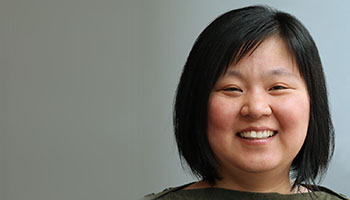
Jing Karchin, PhD, describes a day in the life of a postdoc.
Editor’s Note: Children’s Hospital of Philadelphia Research Institute recently celebrated National Postdoctoral Appreciation Week. But what does a postdoctoral fellow (postdoc) actually do? To answer this question, Jing Karchin, PhD, a postdoc in the lab of Michael S. Marks, PhD, shares a day in her life as a postdoc at CHOP. Her primary work is “wet bench” research, which involves conducting experiments mainly in a laboratory setting. Dr. Karchin shares in this guest blog what a typical day looks like:
6 a.m.
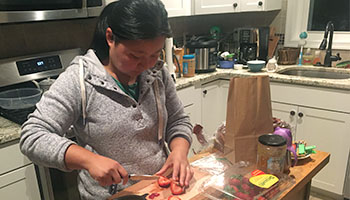
Preparing breakfast and lunch for daughter.
My 2.5-year-old toddler needs to be at her daycare around 7:30 a.m., so I wake up early to get ready for the day. I grab a quick bowl of cereal and milk, and then I make breakfast and lunch for my daughter. I wake her up around 7 a.m. so that she has enough time to get dressed and brush her teeth.
7:30 a.m.
I drop off my daughter at daycare. Because of the coronavirus pandemic, we both go through daily questionnaires and temperature checks before she is allowed into the building. I commute to work by car so that I have the flexibility to leave and pick her up early, if needed. It usually takes me 45 to 60 minutes to get to work, depending on the traffic.
9 a.m.
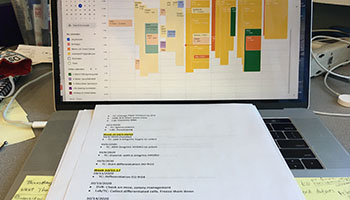
The work day starts.
Now, my work day officially starts. I study the effect of loss of intracellular serotonin in platelets in the events of bleeding. The first research question I’m exploring is whether serotonin loss affects platelet activation. I have a list of things to accomplish for the day, which I planned the week before. It’s important that I have each day and each week organized because some of the experiments require extensive preparation. Certain reagents and equipment need to be ordered or reserved ahead of time.
9:30 a.m.
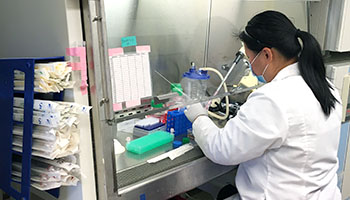
In the lab, taking care of cultured cells.
I’m taking care of cultured cells today. Cells are a great model system for scientific research. These cells are usually isolated from animals or humans, and they’re engineered to survive in a plastic dish in the lab. Researchers can test many things using different cell lines. For example, we can study whether cancer cell migration slows down after treatment with a drug, or we can test if stem cells differentiate into a particular cell type using a combination of molecules. Very exciting, right? I need to start differentiating my progenitor cells to a specialized cell type called “megakaryocytes.” These are giant cells in the blood that can eventually produce platelets, which are essential to stop further bleeding in a bleeding event.
11 a.m.
Now, I check on my research animal models. Animal models are helpful to study certain disease mechanisms because of the similarity of their physiologies and disease pathologies when compared to humans. I’ve completed rigorous training on animal welfare principles, proper animal care, and my ethical and legal responsibilities when working with animal models in research.
12:15 p.m.
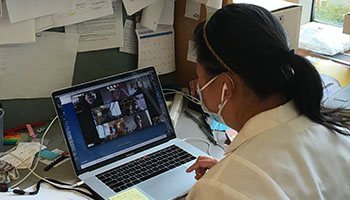
On a virtual meeting with lab members.
The Marks’ Lab has regular meetings to keep track of each other’s research progress and discuss lab business. Usually at the meeting, one of the lab members will present his or her recent research progress and talk about any difficulties or questions that came up while conducting the experiments. This is a great opportunity to get some feedback from our colleagues and our principal investigator. Labs at CHOP Research Institute currently are operating at 75 percent staffing levels due to the pandemic, so research labs may hold hybrid meetings with some staff attending in person wearing masks and physically distancing, while other teammates join virtually. For our lab meeting, we mostly hold it virtually.
2 p.m.
I have half an hour before my next meeting, so it’s a perfect time to eat lunch. The Research Institute facilities groups have identified spaces where we can take breaks and dine comfortably while maintaining safety practices.
2:30 p.m.
Today is the monthly check-in session of the CHOP Postdoctoral Alliance, where I serve as the Communications subcommittee chair. The CPA formed in spring 2019 to enhance the postdoctoral experience at CHOP and to promote an environment conducive to CHOP postdocs’ happiness and success. We celebrated our one-year anniversary this summer. Even though we are still a young organization, we have accomplished several goals. We host monthly virtual events, such as Peer Mentoring Circle for Postdoc Women, and Lunch and Learn. The Communications subcommittee sends out monthly newsletters and event announcements, manages the CPA Twitter account, and it drafts statements to the CHOP postdoc community.
3:30 p.m.
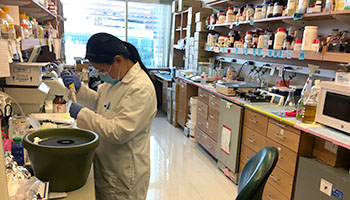
Conducting more experiments.
After both meetings are done for the day, it’s time for more experiments. One thing I like about doing research is that you can ask one question, test it, and get an answer. Then we can ask another one, and then test that. The cyclical feature of scientific research is the most exciting part. Of course, research is not always straightforward. Often, the experiments don’t work as expected, or we need to revise our hypothesis and do it all over again. That’s why it can sometimes take years for research to be published.
5 p.m.
Usually, if I’m done work early, I pick up my daughter from the daycare around 5 p.m., but my husband picks her up today instead. The CPA often shares information about how postdocs can manage, prioritize, and balance the many demands of both their professional and personal lives. I use the extra time to go through my to-do list again before I head home. Tomorrow’s schedule shows I have a mentor meeting, which is a great opportunity to get guidance and create short- and long-term objectives to shape my scientific career.
6:30 p.m.
Dinner and toddler play time!
9 p.m.
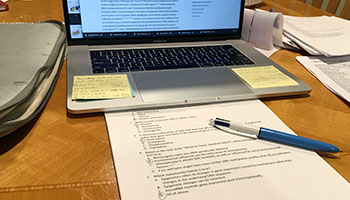
Catching up on some emails and notes.
After putting my daughter to sleep, I usually work another hour or two to catch up with my emails and notes. This also is a good time to finish grading assignments and prepare new lectures, as I’m an adjunct lecturer at Cabrini University where I teach night classes to non-biology students. Living the postdoc life can be busy at times, but I find the most rewarding parts to be designing and troubleshooting experiments, collaborating with lab teammates, and learning as much as I can to succeed in the next phase of my career.